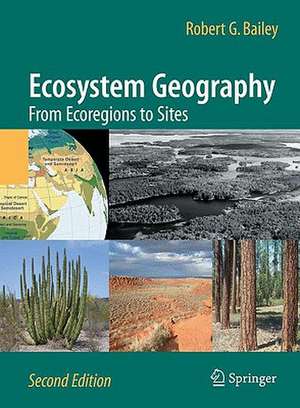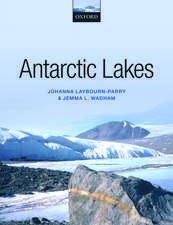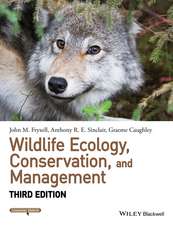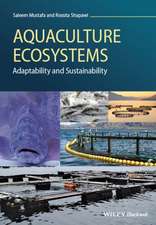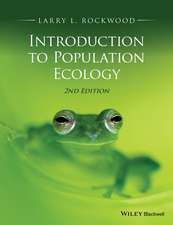Ecosystem Geography: From Ecoregions to Sites
Autor Robert G. Baileyen Limba Engleză Hardback – 16 noi 2009
Preț: 375.99 lei
Nou
Puncte Express: 564
Preț estimativ în valută:
71.95€ • 75.31$ • 59.88£
71.95€ • 75.31$ • 59.88£
Carte tipărită la comandă
Livrare economică 26 martie-01 aprilie
Preluare comenzi: 021 569.72.76
Specificații
ISBN-13: 9780387895154
ISBN-10: 0387895159
Pagini: 251
Ilustrații: XIII, 251 p.
Dimensiuni: 178 x 235 x 23 mm
Greutate: 0.62 kg
Ediția:2nd ed. 2009
Editura: Springer
Colecția Springer
Locul publicării:New York, NY, United States
ISBN-10: 0387895159
Pagini: 251
Ilustrații: XIII, 251 p.
Dimensiuni: 178 x 235 x 23 mm
Greutate: 0.62 kg
Ediția:2nd ed. 2009
Editura: Springer
Colecția Springer
Locul publicării:New York, NY, United States
Public țintă
GraduateCuprins
Scale of Ecosystem Units.- The Question of Boundary Criteria.- Role of Climate in Ecosystem Differentiation.- Macroscale: Macroclimatic Differentiation (Ecoregions).- Ecoclimatic Zones of the Earth.- Ecoregions of the United States.- Ecoregion Redistribution Under Climate Change.- Mesoscale: Landform Differentiation (Landscape Mosaics).- Microscale: Edaphic-Topoclimatic Differentiation (Sites).- Applications of Ecosystem Geography.- Summary and Conclusions.
Textul de pe ultima copertă
The first edition of this book, Ecosystem Geography, examined the distribution of ecosystems at different scales, and the processes that have differentiated them. It presented the principles for ecosystems mapping and explored the connections between ecosystem geography, conservation, and management. Ecosystem Geography was written in 1996, at a time when few published materials on ecosystem geography were available, and none had systematically elaborated the principles underlying the mapping of ecosystems in a form accessible to advanced students and practitioners. This second edition, Ecosystem Geography: From Ecoregions to Sites, builds on the strengths of its predecessor, incorporating new information and clarifying concepts presented in the first edition. New sections address how ecoregion boundaries were determined, ecoregion redistribution under climate change, ecosystem processes (such as fire regimes), empirical versus genetic approaches to classification, and human modification to ecosystems, such as through the introduction of invasive species.
From reviews of the first edition:
"An important book, richly illustrated with clear diagrams, maps, and photos. A major contribution to ecosystem ecology and an essential acquisition." –Choice
"The new ‘ecosystem management’ demands an understanding of ecosystems and the relationships between them. In short, it requires a sound geographical knowledge of ecosystems. Ecosystem Geography lays a firm foundation for such knowledge." –Progress in Physical Geography
"The book is essential reading for ecologists and natural area managers interested in ecosystem management and understanding how their landscapes fit into the larger picture regionally, continentally, and globally." –Natural Areas Journal
About the Author:
Robert G. Bailey is a geographer with the United States Forest Service, Rocky Mountain Research Station, in Fort Collins, Colorado, and the former leader of the agency's Ecosystem Management Analysis Center. His work involves the application of ecosystem geography to ecological planning and design.
From reviews of the first edition:
"An important book, richly illustrated with clear diagrams, maps, and photos. A major contribution to ecosystem ecology and an essential acquisition." –Choice
"The new ‘ecosystem management’ demands an understanding of ecosystems and the relationships between them. In short, it requires a sound geographical knowledge of ecosystems. Ecosystem Geography lays a firm foundation for such knowledge." –Progress in Physical Geography
"The book is essential reading for ecologists and natural area managers interested in ecosystem management and understanding how their landscapes fit into the larger picture regionally, continentally, and globally." –Natural Areas Journal
About the Author:
Robert G. Bailey is a geographer with the United States Forest Service, Rocky Mountain Research Station, in Fort Collins, Colorado, and the former leader of the agency's Ecosystem Management Analysis Center. His work involves the application of ecosystem geography to ecological planning and design.
Caracteristici
The first edition (1996) was written at a time when few published materials on ecosystem geography were available, and none of these had systematically elaborated the principles underlying the mapping of ecosystems in a form accessible to advanced students and practitioners This second edition builds on the strengths of its predecessor, is updated, clarifies concepts that some reviewers have experienced difficulty in understanding, and contains new sections Includes supplementary material: sn.pub/extras
